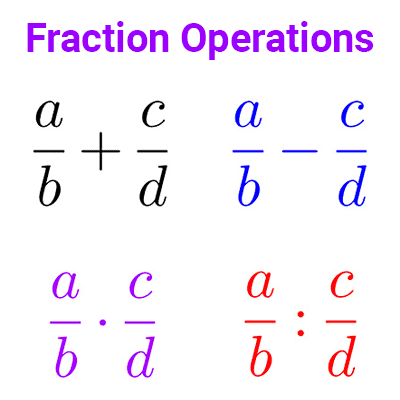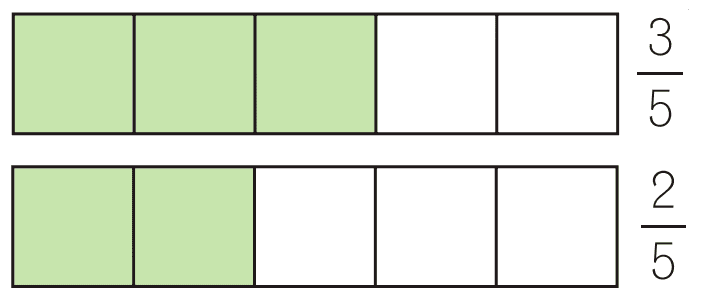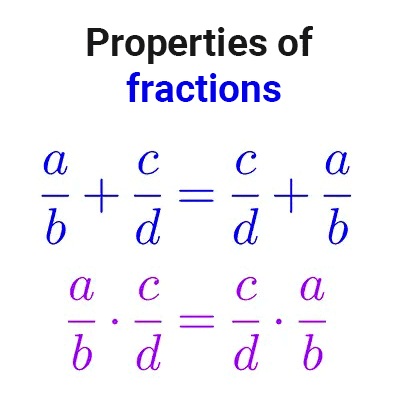
Ordering fractions
In this article we explain how to order fractions in ascending or descending order. We will see solved examples step by step.
Table of Contents
Order of fractions
In rational numbers, there exists an order relationship so that, if we have two fractions, we can determine which one is greater (if they are not equal).
Given two irreducible fractions *\dfrac{a}{b}* and *\dfrac{c}{d},* it holds that
*\dfrac{a}{b}<\dfrac{c}{d}* if and only if *ad<bc*
How to order fractions
To achieve fraction ordering, we have two possible approaches: to analyze the fraction directly or to find the corresponding decimal expressions and compare them. We will focus on doing the former.
The following criteria help us compare positive fractions:
- When two fractions have the same denominator (they are homogeneous), the fraction with the greater numerator is larger.
- When two fractions have the same numerator, the fraction with the smaller denominator is larger.
- An improper fraction is always greater than a proper fraction.
If you are working with negative fractions, the criteria change. Additionally, we can add that every positive fraction is greater than a negative fraction.
When two fractions have different denominators and numerators, you can find equivalent fractions with the same denominator and compare the numerators.
Same denominator fractions
If two positive fractions have the same denominator, the one with the greater numerator is larger.
Example 1: comparing the fractions *\dfrac{3}{5}* and *\dfrac{2}{5}*
Both fractions have the same denominator and are proper, so the one with the greater numerator will be larger:
*\dfrac{3}{5}>\dfrac{2}{5}* because *3>2*
Example 2: order the fractions from least to greatest: *\dfrac{17}{8},* *\dfrac{2}{8}* and *\dfrac{5}{8}.*
All three fractions are homogeneous, so the one with the smallest numerator will be smaller, and the one with the largest numerator will be larger, resulting in the following order:
*\dfrac{2}{8}<\dfrac{5}{8}<\dfrac{17}{8}* because *2<5<17*
It could also be deduced that the last one is the largest because it is an improper fraction, and the others are proper.
If two negative fractions have the same denominator, the one with the smaller numerator is larger.
Example: order the fractions from greatest to least: *-\dfrac{5}{7},* *-\dfrac{8}{7}* and *-\dfrac{27}{7}*
Fractions closer to zero will be larger than the others, keeping this in mind, we apply the rule and arrive at:
*-\dfrac{5}{7}>-\dfrac{8}{7}>-\dfrac{27}{7}*
because *5<8<27* (or *-5>-8>-27*)
If we need to order positive and negative fractions, we do the corresponding ordering within each group, remembering that negative fractions are always smaller than positive ones.
Example: order the fractions from least to greatest *\dfrac{5}{2},* *-\dfrac{5}{2},* *\dfrac{14}{2},* and *-\dfrac{1}{2}*
In the negative group: *-\dfrac{5}{2}<-\dfrac{1}{2}* because *5>1*
In the positive group: *\dfrac{5}{2}<\dfrac{14}{2}* because *14>5*
Combining the information, we can order them all as follows:
*-\dfrac{5}{2}<-\dfrac{1}{2}<\dfrac{5}{2}<\dfrac{14}{2}*
Same numerator fractions
When two positive fractions have the same numerator, the one with the smaller denominator is greater.
Example: order from greatest to least the fractions *\dfrac{2}{17},* *\dfrac{2}{8}* and *\dfrac{2}{5}.*
Applying the rule:
*\dfrac{2}{5}>\dfrac{2}{8}>\dfrac{2}{17}* because *5<8<17*
The rule follows the logic that if we take the same number of parts of a whole, we will have more when the whole is divided into fewer parts. For example: if we can eat two slices of a pizza, we will eat more pizza when it is divided into 4 slices than when it is divided into 8.
When two negative fractions have the same numerator, the one with the larger denominator is greater.
Example: order from least to greatest the fractions *-\dfrac{2}{17},* *-\dfrac{2}{5}* and *-\dfrac{2}{8}*
Solution: *-\dfrac{2}{5}<-\dfrac{2}{8}<-\dfrac{2}{17}* because *17>8>5*
Fractions of different numerator and denominator
To order two or more fractions with different numerators and denominators, you must find equivalent fractions with the same denominator and compare the numerators using the first criterion.
To do this, follow these steps:
- Find the least common multiple (LCM) of the denominators. This will be the new denominator for all the fractions.
- Divide the LCM by each original denominator and multiply the result by the numerator. This will be the new numerator for the corresponding fraction.
How to calculate the least common multiple of the denominators
- Factorize the denominators into prime factors.
- Select the common and uncommon factors raised to the highest exponent.
- Multiply the factors; the result is the least common multiple.
Example 1: order from least to greatest the fractions: *\dfrac{7}{3},* *\dfrac{21}{10}* and *\dfrac{11}{15}*
First, break down the denominators to find the least common multiple:
*3=3*
*10=5\cdot 2*
*15=3\cdot 5*
*LCM(3,10,15)=3\cdot 5\cdot 2=30*
The new denominator for the fractions will be *30.* To calculate the numerator for each fraction, divide this number by each denominator, and multiply the result by the numerator.
For example, for *\dfrac{7}{3},* divide 30 by 3:
*30:3=10*
Then, multiply this result by 7:
*10\cdot 7=70*
So, the new numerator will be 70, resulting in *\dfrac{7}{3}=\dfrac{70}{30}*
For the other fractions:
*30:10=3, 3\cdot 21=63.* So *\dfrac{21}{10}=\dfrac{63}{30}*
*\dfrac{11}{15}=\dfrac{11\cdot 2}{30}=\dfrac{22}{30}*
Now we can compare because the fractions have a common denominator:
*\dfrac{22}{30}<\dfrac{63}{30}<\dfrac{70}{30}* because *22<63<70*
So, replacing the fractions with their original equivalents:
*\dfrac{11}{15}<\dfrac{21}{10}<\dfrac{7}{3}*
Example 2: order *\dfrac{1}{2}, \dfrac{3}{4}, \dfrac{5}{8}* and *\dfrac{7}{10}* in descending order.
Calculate the LCM of the denominators:
*2=2*
*4=2^2*
*8=2^3*
*10=5\cdot 2*
*LCM(2,4,8,10)=2^3\cdot 5=40*
Now, find the equivalent fractions for each of the original ones.
*\dfrac{1}{2}=\dfrac{1\cdot 20}{40}=\dfrac{20}{40}*
*\dfrac{3}{4}=\dfrac{3\cdot 10}{40}=\dfrac{30}{40}*
*\dfrac{5}{8}=\dfrac{5\cdot 5}{40}=\dfrac{25}{40}*
*\dfrac{7}{10}=\dfrac{7\cdot 4}{40}=\dfrac{28}{40}*
With all the fractions having the same denominator, we can order them from greatest to least:
*\dfrac{30}{40}>\dfrac{28}{40}>\dfrac{25}{40}>\dfrac{20}{40}* because *30>28>25>20*
Replacing with the original fractions:
*\dfrac{3}{4}>\dfrac{7}{10}>\dfrac{5}{8}>\dfrac{1}{2}*


Other articles that may interest you